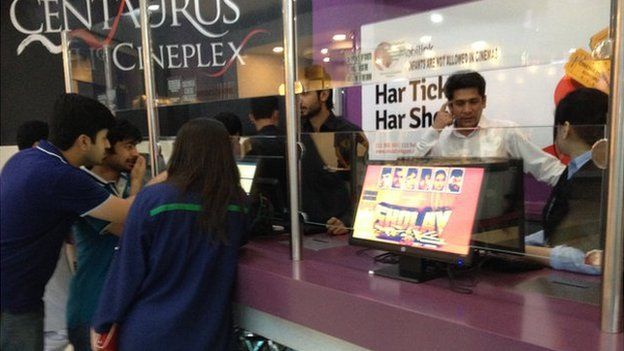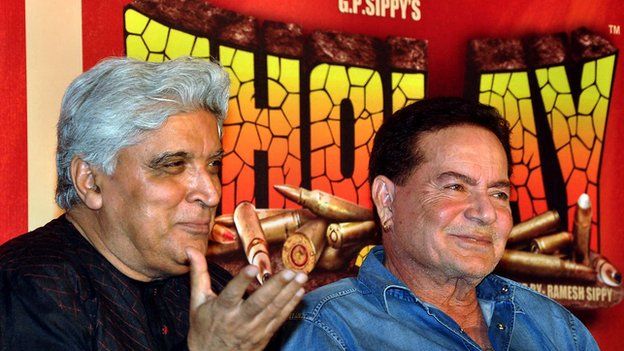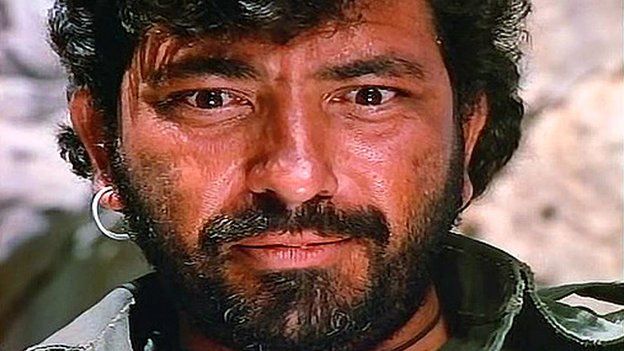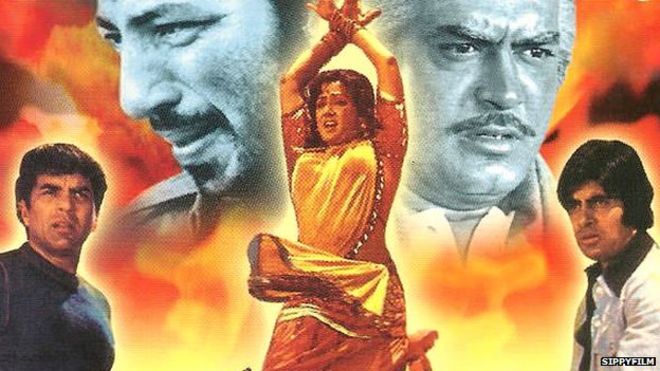Iconic Bollywood movie Sholay has been finally released in cinemas in Pakistan nearly 40 years after it first took India by storm, writes the BBC's M Ilyas Khan in Islamabad.
It might never have been shown in a cinema before - but that doesn't mean the audience don't know the lines.
"How many were they?" asks Gabbar Singh, Bollywood's most recognisable bad guy, delivering one of his most memorable lines in his familiar drawl, tinged with irony.
Before the dark, fat-cheeked henchman of Singh's extortion brigade can utter his line, a giggly female voice from the back row beats him to it, whispering: "They were two, chief."
And the audience continue to respond to dialogue, situations and songs with a quip, a laugh or a slap on the thigh throughout the 204-minute film.
'Delivers the punch'
That, to most people, is the real magic of Sholay (Embers), the 1975 blockbuster which is reputedly Bollywood's most-watched film worldwide.

"People come to see it not for its drama or suspense - everyone has seen it at least once - but because it never ceases to deliver the punch," says one viewer at Islamabad's Centaurus Cineplex.
The movie hit the big screen in Pakistan on 17 April and even though it's 40 years old, it hasn't yet run out of wind, says Aamir Haider, a director of Mandviwala Entertainment, the company that owns Sholay's distribution rights in Pakistan.
"During the first week of its release, it has grossed 4.5m Pakistani rupees ($45,000), which is just about a tenth of what you'd expect from a new [Bollywood] blockbuster like PK, but still enough if you also count the prestige that goes with showing an old classic," he says.
"In fact, Sholay has done better than most Indian films older than 10 years shown in Pakistan so far, including Devdas, the 2002 classic which, besides being a mega hit, starred Shah Rukh Khan, who is widely popular among Pakistanis," he says.
Enduring appeal
So what is the secret of Sholay's enduring appeal?
It is the usual good-versus-evil saga which traces the battle of Ramgarh, a fictitious village in India's northern Uttar Pradesh, against a maniacal and sadistic bandit, Gabbar Singh, arguably the most powerful character in the film.

The story is told through the exploits of two small-time thieves, Jai and Veeru, played by superstars Amitabh Bachchan and Dharmendra, and the bond that they build with a former jailer and prominent landowner of Ramgarh, Thakur Baldev Singh.
Seen by many as having been inspired by the spaghetti Westerns of the 1960s, Sholay succeeded in turning all the themes, situations and characters of that genre into an Indian narrative.
Its power came from its memorable dialogue, delivered by characters finely etched with individual traits and nuances.
Bollywood's leading lady of the 1970s, Hema Malini, gave a memorable performance as Basanti, the talkative village belle who drives a horse cart and romances Veeru. Her conversations with her mare, Dhanno, became the stuff of legends.

It was an ambitious project too, shot in panoramic 70mm cinemascope, with some of Bollywood's most brilliant cinematography of the time.
Pakistani audiences's first introduction to the film was not visual, but in the shape of 120-minute audio tapes that came pouring in as gifts from friends and relatives working in the Gulf - a major market for Bollywood.
Some time later, pirated video tapes become available.

Pakistan banned Indian films after the 1965 war between the two countries, and they are still off the Pakistani list of "importables" from India.
But there has been an easing of that policy since 2006, when Mandviwala Entertainment was allowed permission to import the 1960 magnum opus, Mughal-e-Azam.
That film performed badly in Pakistan when he showed it, says Mr Haider, so when the company proposed to import Sholay, Mr Haider had his reservations.
Cult film
"I said, no-one knows Dharmendra today. Sanjeev Kumar is dead, and so is Amjad Khan. Hema Malini to this generation is just the docile mother-in-law fromBaghban, and Amitabh Bachchan is the guy who hosts TV quiz show Kaun Banega Crorepati (Who Wants to be a Millionaire?)."
Mr Haider admits he was wrong.

"You can't compare Sholay to PK in terms of popular appeal, but you also don't expect a 40-year-old film to fill up 30% to 40% of today's expensive new-generation multiplex theatres, which Sholay has surprisingly done."
He says part of the reason may be that the Sholay print has been digitised and released in 3D.
But it is also because neither Mughal-e-Azam nor Devdas - or any other movie before or since - has added to the local slang in the same way as Sholay has done.
Hameed Bhutto, a film and television journalist based in Karachi, gives me a quick example.
"A friend who helped me buy a car called me a few days later and asked, how's your Dhanno doing," he says.
"It's a bit high on fuel consumption, I replied, without for a moment doubting that he was asking me about the car and not about Dhanno the mare that ran like hell to save Basanti from Gabbar Singh."


No comments:
Post a Comment